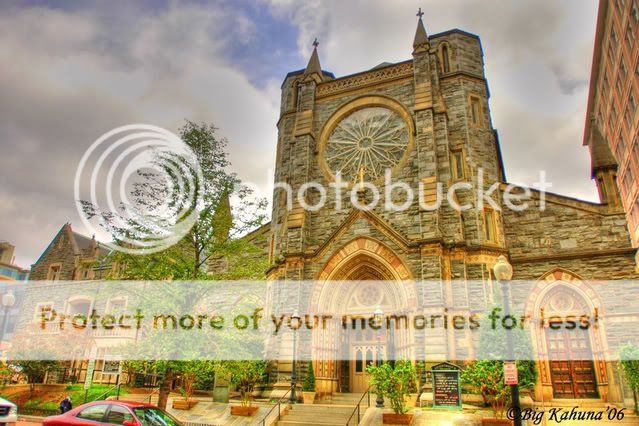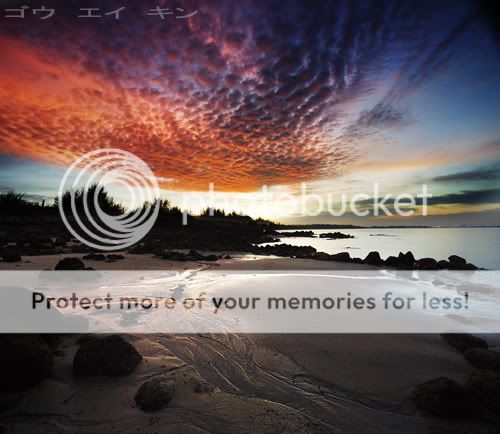Hdr
- Thread starter ReiszRie
- Start date
You are using an out of date browser. It may not display this or other websites correctly.
You should upgrade or use an alternative browser.
You should upgrade or use an alternative browser.
- Status
- Not open for further replies.
This one is very easy http://www.hdrsoft.com/
so do i use the bracketing feature of my cam or should i manually adjust the shutter for different exposure values? if i'm taking a shot of lets say a busy street at dusk, would the lag between each shot of exposure affect the eventual outcome outcome of the photo? is there a general rule of thumb of how long one should take to complete the shots of multiple exposures?
thanks.... havent got a chance to really try it out yet
I usually use bracketing. I guess it's OK to do manual adjustment but I think it's very difficult not to shift the lens even if you have a very stable tripod :sweat: It's very common for HDR if your object is moving, like a motion picture.....I have some sample.....because I did it hand held and the leaves on the tree was swaying....so the final output becomes not so sharp :sweat:


ahh, so it does seem that HDR isn't a very practical method.... hmmm it'll probably be worse if i'm taking a busy street during dusk, you'll get lotsa blurring which isn't very much like blurring caused by long shutter.... in other words kinda ugly blurrings
I never bracket. One exposure captured in RAW. Then developed (WITHOUT exif, impt else CS2 will not work) at maybe -3 -1 and +1. Then merge using the HDR function in CS2.
Or just develop into a 16bit tiff and apply levels with masking.
examples
The foreground is totally in the shade, no sunlight while the sun is shining fully on the white clouds. Notice the details even in the brightest portion of the clouds

Second example.
The sky is MUCH brighter than the reflection on the black road. This picture is basically a HDR merge of three exposures -3, -1 and +1 stops of one single raw file. Unedited so it looks a bit dull but all the details from the light and dark regions are there. Should look better with some level masking.

Or just develop into a 16bit tiff and apply levels with masking.
examples
The foreground is totally in the shade, no sunlight while the sun is shining fully on the white clouds. Notice the details even in the brightest portion of the clouds

Second example.
The sky is MUCH brighter than the reflection on the black road. This picture is basically a HDR merge of three exposures -3, -1 and +1 stops of one single raw file. Unedited so it looks a bit dull but all the details from the light and dark regions are there. Should look better with some level masking.

can also be done with 2 frames with 2 exposures

also check out the website below for excellent examples of HDR application, there are tutorials as well ... this photographer's images simply amazes everyone ...
http://www.cambridgeincolour.com/cambridge-gallery.htm

also check out the website below for excellent examples of HDR application, there are tutorials as well ... this photographer's images simply amazes everyone ...
http://www.cambridgeincolour.com/cambridge-gallery.htm
anyway. please do a search within the forums...
HDR has been discussed before recently only.... last month IIRC.
if im not wrong, i think i was the TS. haha. anyways, for great HDR shots, check out this guy: www.fotobyimran.com
can also be done with 2 frames with 2 exposures

beautiful. The problem with 2 frames is that the scene must be static. no wind, no moving trees, etc. Not to mention that you have to have a tripod...
Basically don't we all want a camera that can capture the entire range from dark to light in one raw file?
beautiful. The problem with 2 frames is that the scene must be static. no wind, no moving trees, etc. Not to mention that you have have a tripod...
Basically don't we all want a camera that can capture the entire range from dark to light in one raw file?
working with 2 files offer more flexibility in terms of the range of editing that can be done before image quality gets affected negatively.
i offer it as an option. the frame i wanted is wider than what my widest lens can take, therefore 2 frames, and because of that 2 exposures. whether HDR is used or not, composition must always come first. HDR is afterall an effect, not an end
the concept of HDR is not new ...
http://www.flickr.com/groups/21151709@N00/discuss/72157594280410378/
the idea is to get light to be where you want in a difficult situation. like for example getting foreground subjects to be lighted in a backlight situation ...

http://www.flickr.com/groups/21151709@N00/discuss/72157594280410378/
the idea is to get light to be where you want in a difficult situation. like for example getting foreground subjects to be lighted in a backlight situation ...

working with 2 files offer more flexibility in terms of the range of editing that can be done before image quality gets affected negatively.
i offer it as an option. the frame i wanted is wider than what my widest lens can take, therefore 2 frames, and because of that 2 exposures. whether HDR is used or not, composition must always come first. HDR is afterall an effect, not an end
ya lar. Your pictures are really very nice and you have higher photographic standards (not sacarstic
For me, photography is basically snapping my wife on my holidays and HDR is basically getting backlited subjects to come out ok. not with a burnt out skies but with beautiful blue skies and white clouds with details and form. I seldom have the leisure or time on my holidays to set up tripod and neither can my wife hold still for that long to take multiple exposures.
So the best I can do is single RAW file exposure on the widest dynamic range camera I can afford.
ya lar. Your pictures are really very nice and you have higher photographic standards (not sacarstic)
For me, photography is basically snapping my wife on my holidays and HDR is basically getting backlited subjects to come out ok. not with a burnt out skies but with beautiful blue skies and white clouds with details and form. I seldom have the leisure or time on my holidays to set up tripod and neither can my wife hold still for that long to take multiple exposures.
So the best I can do is single RAW file exposure on the widest dynamic range camera I can afford.
thanks ... i never say your method is wrong. i'm only offering another way of doing it yah?
so should i do a single exposure of 2 exposure shots or varying EV? how much difference should the EV be between 2 shots?
i'm using a Nikon D80
it depends on the amount of contrast present in the situation.
RAW files allow up to +/-2, but best within the range of +/- 1.
at +/- 2 i find image quality starting to get difficult to control.
therefore, there are times when shooting 2 exposures can help.
add: if you shoot a single frame with 2 different exposure values in RAW file format, you actually expand the range possible for post processing.
- Status
- Not open for further replies.
Similar threads
- Replies
- 0
- Views
- 126
- Replies
- 0
- Views
- 72
- Replies
- 0
- Views
- 65
- Replies
- 0
- Views
- 92
- Replies
- 0
- Views
- 49


